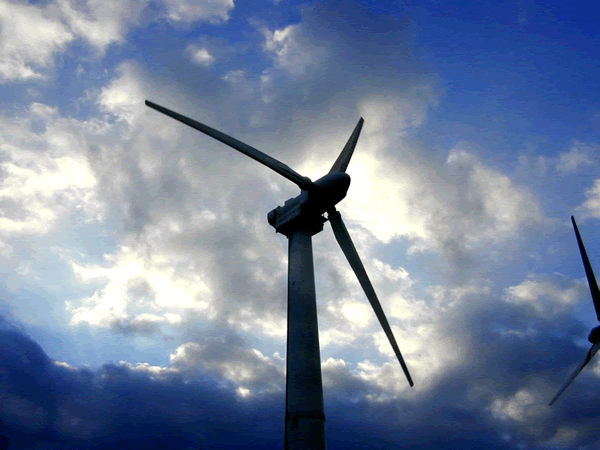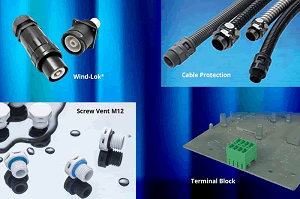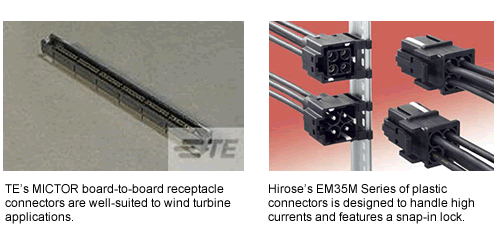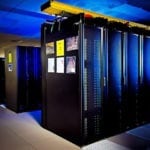Connectivity Solutions for Wind Energy Electronics
There’s no stopping the wind, so we may as well harvest it.
By Amy Goetzman and Christine Stieglitz

Wind farm installations continued to expand in 2017, with additional capacity added around the globe, notably in places like Texas, Turkey, France, the UK, and India. Wind energy contributed an annual €36 billion ($43 billion) to the European Union’s GDP in 2016 and accounted for 263,000 jobs. In the US, 102,500 people are now employed by the wind industry — a fifth of those in Texas alone. And, this number doesn’t include the number of people who are employed by traditional utility companies, who now also work with the collecting and transferring of extra wind energy to the existing grid. However, this young industry is still evolving, and its technology is continuously undergoing refinement. Concerns about equipment longevity, energy storage, and safety to migratory birds are spurring new turbine designs and complementary systems.
Within the turbine system itself, a key challenge to designers has been keeping internal components safe from heat buildup. As the turbine spins and generates energy, heat builds up within the nacelle, the central housing structure that contains the energy-generating equipment. This structure contains a shaft, gearbox, brake, generator, bearings, a full complement of electronics that power and control the various systems, and cabling including fiber, coax, Ethernet, and electrical lines. To help simplify these complex systems, turbine designers often employ modular and hybridized connectors designed to withstand extreme environmental conditions, and especially high or extreme temperatures, over long lifetimes.

The Wind-Lok® line of connectors from Amphenol Industrial Products Group is designed to speed up installation of wind systems.
“Thermal management for wind turbines, or any other device, is as much a business consideration as it is a technology one. When a turbine is down due to heat-induced failure, companies face expensive ‘truck rolls’ (i.e., repair crew dispatches), as well as the operating losses that rapidly accumulate when a nacelle is offline,” said Cary Eskow, vice president, global LightSpeed business, Avnet.
To prevent excessive heat from impacting the function or longevity of the electronics — or even, at the extreme end of possibilities, causing a fire in the nacelle — the generated heat must be effectively dissipated. Several cooling systems are available to help minimize these risks, but options including forced air and water cooling systems generally require more maintenance than is practical or cost-effective for offshore and other remote installations. The cooling systems in these types of installations, which include evaporative cooling and combined forced air and liquid cooling systems, need to be more self-sufficient, which is accomplished in part by components especially designed for extreme environmental conditions. Replacing hardwiring with proven harsh-environment connectors in these systems delivers the high-reliability, long-lifetime performance these installations demand, as well as facilitates easier assembly, disassembly, testing, troubleshooting, maintenance, and subassembly updates within the system.
Connectors solutions for wind energy applications include: threaded and bayonet-style circular connectors, including sensor input connectors, rectangular I/O connectors, heavy duty modular connectors, fiber optic connectors, RJ45 connectors, and terminal blocks, and are manufactured by suppliers including Amphenol Industrial Products Group, Hirose, HARTING, TE Connectivity, Weidmuller, HUBER+SUHNER and others.
Ideal characteristics for connectors employed in wind turbine applications include:
- Modular designs that enable enhanced flexibility with regard to form factor, performance, and system updates
- Lightweight, low-profile, and small form factor housings
- Ruggedized shell, plating, and contact materials
- Combined power, signal, and/or data transmission capabilities
- Proven high-reliability performance in harsh-environment conditions including: extreme temperatures, high vibration, liquid, dust/dirt, lightning, etc.
- High current and voltage handling capabilities
- EMI shielding and lightning protection
- Robust sealing against both solid and liquid ingress
- Physical coding features that prevent mismating even in blind mating applications
- Visual, audible, or tactile confirmation of positive coupling
- Quick-connect/disconnect functionality
- Locking mechanisms
- High mating-cycle durability
- Strain relief features

Wind turbines — and especially offshore wind turbines, which already account for a large portion of the segment — are projected by Research and Markets to grow by a compound annual growth rate (CAGR) of 25.47% from 2016 to 2021. Existing infrastructure is also being updated to include the latest components, including sensors capable of transmitting data about the wear and condition of components, the temperature within the system, and turbine function, load, and operations. Sensors are especially important in offshore wind farms and other areas where ice accumulation is an issue.
“Sensors are often the most mission-critical components in a wind turbine system. Ruggedized sensors can monitor gearbox-generator coolant flow, temperature, and even air quality,” said Eskow. “Sensors can identify pending thermal problems and send this data to the utility’s central management system so the issue can be resolved before it causes the system to fail. Sensors like the Telaire SMART Dust Sensor from Amphenol Advanced Sensors can measure the concentration of tiny airborne particles that build-up on bearings and gears, providing an early warning before friction and the resulting heat causes problems. Embeddable thermal imagers like those from FLIR Systems Inc. can sense heat signatures to identify areas that could potentially overheat. I believe thermal management for wind turbines is an excellent example of the power of using sensors and IoT for predictive maintenance of cooling systems.”
The data these systems collect will also help designers create more efficient and effective electronics systems for future wind farms and upgrades to existing equipment.
“A wind farm IoT network can analyze historical operating data to analyze trends, which operators can use to create a model that can predict what components to inspect and when,” says Barry Manz for Mouser Electronics.
“Temperature sensors are used in places in the system where increases in temperature indicate overheating in some type of component of subsystem. For example, TE Connectivity’s PTF Platinum temperature sensors measure from -200°C to +600°C and have temperature detectors that use thin-film resistors as the sensing element.”
As these technologies evolve, wind energy will become even more efficient and prices will continue to drop. Ultimately this will increase demand for the robust, harsh-environment connector and cabling solutions these systems depend on.
Recently posted:
[related_posts limit=”10″]
- State of the Industry: 2022-2023 Connector Sales - April 16, 2024
- Amphenol is On a Roll - April 2, 2024
- Nicomatic Proves That Two Heads are Better Than One - March 26, 2024






